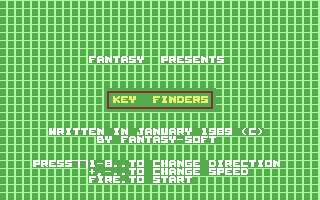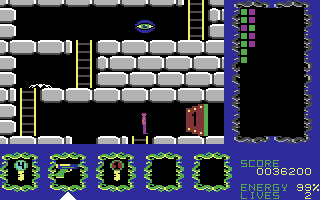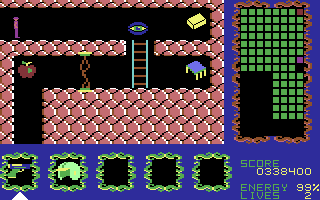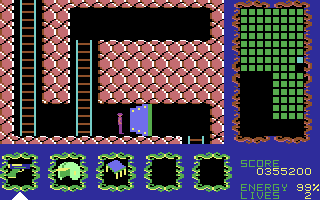It's time to journey underground into a vast maze filled with valuables, creatures, and numbered keys. This is Keyfinders, an action adventure game inspired by Hero of the Golden Talisman (Mastertronic, 1985).
In the diskmag article, the game is interchangeably referred to as KEY-FINDERS, KEYFINDERS, and KEY FINDERS, which is quite the achievement for a text that's only six paragraphs long. In Italy, the game was released under the name Nebraska Joe, which is kind of ridiculous but thankfully didn't allow for as many alternative ways to write it. I decided to go with the name Keyfinders, as that's how it was written on the magazine cover.
 |
| Proudly sponsored by the color green! |
If I stay on the title screen for long enough, the game switches into an attract mode where it shows several locations of the game (without giving away where in the maze they are). Let me just press fire to prevent any premature spoilers as to what awaits in the underground corridors.
The start of the game shows Joe plummeting down into the maze and then staring silently at the giant bat fluttering around in front of him. He's probably contemplating his chances of survival, seeing how he's apparently completely unprepared for this venture. His fetching purple outfit (with matching hat and shoes) might raise a lot of attention at parties, but that's not exactly what he'd want in a place full of hostile creatures.
The main game takes place in the top left view. To the right is a handy mini-map of the entire maze that updates with each visited room. The five ornate panels at the bottom are used to retrieve and immediately frame five stolen paintings the player has to find in the maze. Here they are as follows:
I am sorry, I made that up. The five panels are not picture frames, they represent Joe's inventory which starts out empty. This just reinforces my impression that he didn't plan on exploring the maze, but fell in by accident.
Lucky for Joe, the bat simply flies back and forth and doesn't take notice of him, even if he's walking right behind it. I think the mammal's echolocation is broken, as it's emitting a sound more akin to a car siren than the usual ultrasonic bat calls. In any case, Joe can just follow it and then climb down the ladder.
The situation is a bit more precarious in the room below. Joe is immediately accosted by another bat that is about to steal his hat if he doesn't get off the ladder in time. This bat only turns around when it has reached the corridor's right edge, so I have to escape to the next room if I don't want to take damage. Enemies never leave the rooms they're in, and their positions reset each time I enter.
You may already feel a bit queasy from the number of anachronisms appearing in the above GIF. Let's ignore the presence of a robot for now and turn our attention to that green BMX helmet. Somewhere in this maze there is a deadly, ceiling-mounted laser cannon (!) that goes off as soon as Joe steps in front of it. The only way for Joe to not get immediately decapitated is to wear this helmet, like so:
My apologies, I seem to have made that up as well. What I wrote about the laser canon is true, but Joe is always shown with his purple hat on, even while wearing the helmet.
The way to the oversized head protection is blocked anyway, so I direct Joe further down instead.
I know it's hard to ignore that patrolling space shuttle at the bottom, but I'd like to explain the glowing bar of soap first. The instructions on the diskmag vaguely call it a cuboid, but I assume it's supposed to be a gold bar. Collecting it rewards 5000 points which makes it the most valuable item in the game.
In the above image you can also see how the mini-map works: Green tiles indicate visited rooms with nothing left to collect in them, while purple ones still contain one or more unclaimed items. The glowing tile is the current room. Hero of the Golden Talisman had a very similar automap system. Here's a screenshot for comparison:
 |
| Hero of the Golden Talisman (Mastertronic, 1985) |
After picking up the gold bar, I have to go back two rooms and face the bat again. Unarmed and without the ability to crouch or crawl, Joe has no other choice but to waltz through the flying bloodsucker and take the damage.
That went better than expected! Joe clearly collided with the bat, which caused him to flash white for an instant (accompanied by a short, discordant noise), but he apparently remained unharmed. Touching an enemy causes a fixed amount of damage at a rate of about three times per second. The amount of energy that gets detracted depends on the creature. The bat only does 1% of damage which makes it one of the weakest enemies in the game.
The room's remaining hazards are less of a problem. By dropping down the right ladder, Joe can avoid the robot entirely, and the blue moving barriers just require the right timing to get through unharmed.
 |
| Eye feel watched. |
Compared to that, the white spider just a floor below seems like an almost ordinary enemy. Do not let that fool you into a false sense of security, though, as the albino arachnid is one of the most dangerous creatures in the game.
Another floor further down, the weirdness continues in the shape of what looks like a sea mine that decided to leave the ocean and evolve into a maze mine.
Apart from demonstrating a slew of enemies, this room also neatly shows the game's main progression mechanic. Just by looking at the above GIF, you as the player can surmise that there are at least four numbered keys to be found, and they only open the doors with the matching numbers.
The monster placement allows for a damage-free path without any forced collisions. I had to drop down that hole to leave the room. Had I chosen the ladder instead, Joe's ribs would've been poked by a space shuttle's pointy nose on the next screen. Yes, this game is a bit weird.
The lower room also contains the last and most lethal type of hazard Keyfinders' maze will throw at the player, the energy trap. If Joe happens to touch its recurring lighting arcs, he dies immediately.
The ladder next to the energy trap spans several rooms down and leads to the item I usually want to grab as soon as possible, the gun. This weapon, unsurprisingly, allows Joe to shoot bullets, and an infinite number of them:
Those flying white dots don't look like much, nor do their dainty plinky sounds induce any serious sense of threat, but they can wipe out all moving creatures in a single hit. All except one, that is. The white, ground-hogging spider cannot be killed because Joe is unable to fire diagonally or even straight up or down.
While Joe can carry up to five items, he can only hold one in his hand at a time. Switching between items is done by pressing space, and the white arrow at the bottom indicates what is currently equipped.
With the gun firmly in his grip, Joe climbs back up the ladder and introduces enemies he passed by earlier to the joys of not existing anymore. Exterminated adversaries disappear with a glinting star and a tinkly sound that is surprisingly satisfying to hear.
At this point, Joe has already encountered all enemies and hazard types the game has to offer. Now that he can defend himself and receive points for each dispatched foe, here's a chart of how many points they are worth (if they can be killed) and how much damage they do:
There's a correlation between both values, i.e. the more dangerous enemy is also worth more points (with a ratio of 400 points to 1% of damage). Unfortunately, the scoring in Keyfinders is a bit meaningless. For one, all enemies respawn when the player re-enters the screen. This means that enemies can be farmed for points indefinitely. Secondly, the game does not keep a high score table, nor are there any extra lives awarded for reaching certain scores. In that regard, playing Keyfinders for a high score is a bit like doing a speed run of a point & click adventure game.
After a bit of backtracking, Joe comes across another key and this time for a door he's already seen.
Opening a door means standing next to it and having the correct key equipped. There's no visible keyhole, so I assume some fancy electronics are involved to make the gate move. Once the door has vanished into the ceiling, the used key disappears, and the inventory impractically switches to the last slot for reasons unknown.
LATER
Oh hey, there's that helmet we saw earlier. You've got to admire Joe's boldness to do a standing leap off a ladder that's this high up. But then, there is no falling damage in the game, so maybe I'd do the same thing if I knew that slipping off a ladder wouldn't result in a lot of broken bones.
See? I didn't lie about the ceiling-mounted laser cannon. As soon as Joe comes close to its height, the gun starts shooting a lethal ray of bundled light. The only way to appease the turret is to wear the green safety helmet in its vicinity. It doesn't deflect the laser, though, but makes it stop instead. I suspect that the helmet, like the key, contains some hidden electronic device that communicates with the cannon. There is further evidence later on that the maze is technologically more advanced than its rough stone walls might suggest.
The giant apple at the top is a healing item worth 30% of energy. In the diskmag article, it is curiously described as a strawberry. This is an interesting mistake if you take into account the following healing item from another game:
Guess what, that's from Heroes of the Golden Talisman. I have a theory that the article was written for an earlier version of Keyfinders that actually contained strawberries instead of apples. The game was initially planned to be released in issue 08/89 of Magic Disk 64. Its name even made it onto the cover, but it couldn't be completed in time. I suspect that the article had already been written at that point and was only marginally changed when the game got eventually released on issue 03/90.
A COUPLE OF ROOMS LATER...
Well, this sucks. Up until now, the enemy placement had been nice enough that damage could largely be avoided. In this room, however, Joe appears right in front of a blue barrier which almost immediately saps away his energy.
On the plus side, here's the last numbered key of this section.
However, two screens further to the right, Joe encounters a door without any number on it. What on earth could open this one?
Why, a blue microchip the size of a dinner table, obviously.
Here's where Keyfinders' level design shows its strength: With the chip in my pocket, I now have to make my way back to the blank door which is in the bottom right corner of the revealed map. If I went back the way I came, this would involve over twenty rooms of backtracking. Thankfully, there's a pit right here that offers a convenient shortcut. It's also fun to drop down several rooms and not take any damage at the bottom.
All visited rooms on the map are green, which means I collected everything. Leaving through the blank door usually means that the previous part of the maze becomes inaccessible for the rest of the game. Thus it's a good idea to check for any purple squares first if you are in a completionist mood.
Joe whips out his chip, and the door's opening mechanism springs into action. This not only clears the way to the next part of the maze, it also removes all items from Joe's inventory. There is something weird going on here, and since the diskmag article doesn't say anything about the game's backstory, I'll now make up my own and call it canon:
 |
| Sam: Expert Key Finder |
There you have it. Keyfinders' story is about a VR simulation that was created to hide a physical key in an alternate version of the Sam & Max universe.
What do you mean, that doesn't make any sense?
Right, let's go back to the actual game:
Keyfinders is divided into four graphically distinct quadrants that exist in the same maze. While there aren't any levels per se, the map is designed in a way that forces the player to visit the quadrants in a fixed order. I've numbered them in the order they are visited, i.e. 1 (top left), 2 (bottom right), 3 (top right), 4 (bottom left).
After opening the first blank door and entering the next room, Joe gets a glimpse of the maze's third (upper right) quadrant. He will eventually exit the second (lower right) quadrant through that blank door. Most first-time players will probably just stumble directly into the pit because Joe appears right at its edge. There's nowhere else to go anyway, so I might as well take the plunge.
That's not even the longest fall in the game. It's an interesting way to show a rapid preview of some of the rooms, and now I already know where the chip can be found in this section.
From here on out, the game's main mechanic of finding four keys and a microchip repeats for each quadrant. There are no new enemies or items introduced that we haven't already seen. This is not a knock on the game, as the level design remains engaging, and none of the quadrants are overly long that they outstay their welcome.
The game remains fair enough that it's possible to go through this second quadrant without taking damage. The gun is a bit more out of the way, but it's still reachable without me having to run through enemies.
The laser cannon makes a reappearance as well, and this time its placement is a bit more insidious. If I ever enter this corridor from the right side, I better have the helmet equipped or I'll get cut in half immediately. Thankfully, the laser doesn't go beyond this room, even though it looks like it should.
LATER
Joe has reached the exit with the chip in his pocket. If you look at the map, you can see that the two bottom rows of the second quadrant remain unexplored. There's a reason for this which will become apparent soon.
For now, let's move into the third quadrant whose walls look unpleasantly fleshy to me. I almost expect Joe's footsteps to make squishy sounds here.
 |
| Joe shot first |
Depending on the order in which you explore the third quadrant's rooms, your first encounter with the laser cannon may result in an immediate death, like I've demonstrated above. If Joe loses a life, he slowly falls to the ground and then gets revived with a pulsating glow around him. This makes him invincible for a short while, allowing him to move away from whatever caused his demise. In any case, let's rewind back to before Joe fell down that pit, as I only wanted to show his death animation.
And there's this quadrant's chip, in the top right corner of the maze. The drop down this room is another convenient shortcut, but this one ends up right in front of the laser cannon. At least you can switch to the helmet even while you're falling down, so players with fast reaction still get a chance to save themselves in case they forgot what is waiting for them at the bottom of the drop.
This is the longest fall in the game, spanning a whopping seven rooms and featuring a bat that can't be avoided. Thanks, game! If you were hoping to do a zero damage run, don't bother, as this single bat makes it impossible to pull off.
Joe lands in the first unexplored row of the second quadrant. This is a straight corridor leading to the left, all the way to the fourth and last quadrant...
... which comes in this homely log house style. The enemies are still out to kill you, of course, but those wooden walls lend the corridors a pleasantly cozy feel.
Since this is the ultimate section of the game, it's also the hardest. The maze feels more complex, and there are two laser cannons to worry about. Despite that, the developer made sure not to go overboard with the difficulty, and even this final quadrant never becomes an exercise in frustration. It features a fun drop that you have to perform in order to pick up the helmet:
 |
| Wheee! |
The pit in this room represents a shortcut, but it comes with a minor catch: The room right below houses a bat that'll collide with Joe if he comes falling down. It's not that the minor energy loss represents any significant threat, but I'd like to avoid hearing the ear-grating damage sound if at all possible. Thus, I'll take the long way around.
A LONG WAY AROUND LATER
This is it, the final door. All I have to do now is go to the right, avoid the last few obstacles, and freedom will be mine. I was hoping to find a great treasure at the end of the maze (e.g. a golden key), but I guess the stacks of gold bars I collected are a nice reward as well.
So, what happens when you complete the game? You get this screen:
I'm kidding (again). That's just a single frame that appeared in my recorded footage right after I had left the final room. Stuff like this happens all the time, usually when a game switches to another screen and doesn't do it neatly between screen updates.
What you actually get is this:
Cool! If you feel so inclined, you can turn on this cheat mode and play with infinite lives. Admittedly, the game isn't very hard to begin with, so this feature is probably not that useful. It's still nice to have, nevertheless.
And that's the game. Now that I've explored the entire maze, here's a map I assembled from all the screenshots I took. Click on the image to open it in full resolution:
If you want to give the game a try but don't like getting lost, I recommend consulting this map from time to time. I found it quite useful when I replayed the game, and it helped me figure out the shortest paths through the maze.
CONCLUSION
I like Keyfinders a lot. It's one of those rare C64 titles that are not particularly difficult to play but still remain engaging. It's not a very long game either. Once you know the maze layout, an entire playthrough takes about half an hour or less.
On the technical side, the game doesn't have much to show, but it is by no means ugly. The graphics are plain but functional, and all the items are recognizable for what they're supposed to represent (with the exception of the soap/gold bar, maybe).
I do like the enemy roster, especially because of its lack of a coherent theme. There aren't a lot of games around where you have to simultaneously fight eyeballs, robots, and space shuttles.
The sound effects are also simple but well-done. Almost every enemy has its own signature noise, and if there are several baddies in one room, you can hear their sound effects combine. The robot, in particular, emits a series of soothing tones that could be potential ASMR material. As I mentioned already, shooting an enemy results in a clinking sound that is surprisingly pleasing to hear. All in all, the sound effects make up for the complete lack of music.
The controls feel fine as they are. Diagonal jumps (e.g. over pits) can be a bit finicky with a joystick, thanks to the "push up to jump" control scheme, but there isn't much one can do about a computer that officially only supports one-button controllers.
I'm not so sold on the idea that inventory items need to be selected in order to use them. The gun is the only item that ever uses the fire button, so why not just let me fire as long as I have a gun with me? Keys should also just be used automatically when I'm near corresponding doors, and Joe might as well wear the safety helmet all the time as soon as he finds it.
The best part of the game, for me, is the level design. Some thought has gone into directing the player through the maze, and deliberately placed shortcuts make extensive backtracking unnecessary. I also like how the game sometimes teases sections of the maze that can only be visited later. There are a few instances where collisions with enemies can't be avoided, and there are a couple of potential death traps, but overall the layout remains fair and encouraging. It's a stark contrast to some of the more notorious games I had to play on this blog that were seemingly designed with open contempt for the player.
The game's ending only consists of a simple text message (plus the reveal of a cheat mode), but in this case, I don't really miss a proper end screen as a reward. Seeing the mini-map completely filled out with green squares (i.e. fully explored) when I leave the maze is satisfaction enough for me.
While Keyfinders was clearly inspired by Heroes of the Golden Talisman, it remains original enough to not be a blatant ripoff. In quite a few ways I'd even say that Keyfinders streamlined the original game and took out some of its frustrations, especially the weird jumping mechanics which caused the protagonist to bounce off walls like a pool ball.
So, should you play Keyfinders? Why yes, you should indeed. It's the perfect game if you're looking for something that doesn't require a large amount of commitment and isn't particularly stressful to play. There are a lot of C64 games that I started playing but never managed to finish. That is why I'm doubly glad to occasionally come across a title that allows me to complete it without making me want to toss my joystick out the window.




































No comments:
Post a Comment